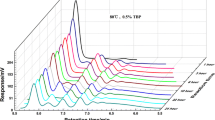Abstract
The expansion of the industrial needs of isocyanurate type polyisocyanates and the increasing pressure on reducing free toluene diisocyanate (TDI) monomer content necessitate a highly selective catalyst to ensure a lower free monomer content in the product. A catalyst screening was performed in terms of catalytic activity and catalytic selectivity. Of all the common trimerization catalysts, oligomeric Mannich base (OMB), as a special type of Mannich base catalysts, was synthesized and proved to have the most enhanced selectivity and enough activity for the oligomerization of TDI. The influence of temperature and catalyst concentration on its catalytic reaction was investigated by comparing their reaction rate and reaction selectivity. Dodecanol as a compatibility modifying agent was found to be a co-catalyst of OMB, with a synergistic effect on both the reaction rate and reaction selectivity. The oligomerization process was followed and investigated by gel permeation chromatography (GPC) and isocyanate (NCO) back-titration.

















Similar content being viewed by others
References
Wang L, Zhao Q, Zhao Y, Lou Y, Zheng M, Yu Y, Zhang M (2016) Determination of heterocyclic brominated flame retardants tris-(2, 3-dibromopropyl) isocyanurate and hexabromocyclododecane in sediment from Jiaozhou Bay wetland. Mar Pollut Bull 113:509–512
Arbenz A, Frache A, Cuttica F, Avérous L (2016) Advanced biobased and rigid foams, based on urethane-modified isocyanurate from oxypropylated gambier tannin polyol. Polym Degrad Stab 132:62–68
Manvi GN, Singh AR, Jagtap RN, Kothari DC (2012) Isocyanurate based fluorinated polyurethane dispersion for anti-graffiti coatings. Prog Org Coat 75:139–146
He Y, Zhou M, Wu B, Jiang Z, Nie J (2010) Synthesis and properties of novel polyurethane acrylate containing 3-(2-hydroxyethyl) isocyanurate segment. Prog Org Coat 67:264–268
Beitchman BD (1966) Isocyanurate syntheses via triethylenediamine-cocatalyst combinations. Ind Eng Chem Prod Res Dev 5:35–41
Tiger RP, Badayeva IG, Bondarenko SP, Entelis SG (1977) Kinetics and mechanism of cyclic trimerization of isocyanates using a tertiary amine-alkylene oxide catalytic system. Polym Sci USSR 19:484–495
Shibanova NA, Zhitinkina AK, Turetskii LV, Varentsova NV (1983) The role of proton-donors in cyclotrimerization of isocyanates by the action of an amine-epoxide catalytic system. Polym Sci USSR 24:2768–2778
Bondarenko SP, Tiger RP, Badayeva IG, Arkhipov AY, Entelis SG (1977) The kinetics and mechanism of the cyclic trimerization of isocyanates on the catalyst system tertiary amine-alkylene oxide, and the modelling of the process on an analogue computer. Polym Sci USSR 19:688–698
Nicholas L, Gmitter GT (1965) Heat resistant rigid foams by trimerization of isocyanate terminated prepolymers. J Cell Plast 1:85–90
Querat E, Tighzert L, Pascault JP, Dušek K (1996) Blocked isocyanate. reaction and thermal behaviour of the toluene 2, 4-diisocyanate dimer. Die Angewandte Makromolekulare Chemie 242:1–36
Buckles RE, McGrew LA (1966) A kinetic study of the dimerization of phenyl isocyanate. J Am Chem Soc 88:3582–3586
McGrew LA, Kruger TL (1971) Kinetic versus thermodynamic control. An organic chemistry experiment. J Chem Educ 48:400
Pusztai Z, Vlád G, Bodor A, Horváth IT, Laas HJ, Halpaap R, Richter FU (2006) In situ NMR spectroscopic observation of a catalytic intermediate in phosphine-catalyzed cyclo-oligomerization of isocyanates. Angew Chem Int Ed 45:107–110
Lin IS, Kresta JE, Frisch KC (1982) The catalysis of the polycyclotrimerization of isocyanates by quaternary ammonium carboxylates. In: Kresta JE (ed) Reaction injection molding and fast polymerization reactions. Polymer science and technology, vol 18. Springer, Boston, MA pp 147–163
Bechara IS, Mascioli RL (1979) The mechanism of the hydroxyalkyl quaternary ammonium carboxylate catalyzed reactions of phenyl isocyanate. J Cell Plast 15:321–332
Zhitinkina AK, Shibanova NA, Tarakanov OG (1985) Kinetics and mechanism of the catalytic cyclotrimerisation and polycyclotrimerisation of isocyanates. Russ Chem Rev 54:1104–1125
Dabi S, Zilkha A (1980) Oligotrimerization of hexamethylene diisocyanate by organometallic catalysts. Eur Polym J 16:831–833
Dabi S, Zilkha A (1980) Synergistic effects in the trimerization of isocyanates by organometallic catalysts. Eur Polym J 16:827–829
Bloodworth AJ, Davies AG (1965) Trimerization of isocyanates by organotin compounds. Chem Commun (London) 2:24–25
Herbstman S (1965) Trimerization of isocyanates by trialkylantimony and arsenic oxides. J Org Chem 30:1259–1260
Orzechowski L, Harder S (2007) Isolation of an intermediate in the catalytic trimerization of isocyanates by a monomeric calcium carbene with chelating iminophosphorane substituents. Organometallics 26:2144–2148
Duong HA, Cross MJ, Louie J (2004) N-Heterocyclic carbenes as highly efficient catalysts for the cyclotrimerization of isocyanates. Org Lett 6:4679–4681
Gibb JN, Goodman JM (2013) The formation of high-purity isocyanurate through proazaphosphatrane-catalysed isocyanate cyclo-trimerisation: computational insights. Org Biomol Chem 11:90–97
Raders SM, Verkade JG (2010) An electron-rich proazaphosphatrane for isocyanate trimerization to isocyanurates. J Org Chem 75:5308–5311
Roman M, Andrioletti B, Lemaire M, Bernard J, Schwartz J, Barbeau P (2011) Investigations providing a plausible mechanism in the hexamethyldisilazane-catalyzed trimerization of alkyl isocyanates. Tetrahedron 67:1506–1510
Barman MK, Baishya A, Peddarao T, Nembenna S (2014) Guanidinate stabilized germanium (II) and tin (II) amide complexes and their catalytic activity for aryl isocyanate cyclization. J Organomet Chem 772:265–270
Giuglio-Tonolo AG, Spitz C, Terme T, Vanelle P (2014) An expeditious method for the selective cyclotrimerization of isocyanates initiated by TDAE. Tetrahedron Lett 55:2700–2702
Guo J, He Y, Xie D, Zhang X (2015) Process investigating and modelling for the self-polymerization of toluene diisocyanate (TDI)-based polyurethane prepolymer. J Mater Sci 50:5844–5855. doi:10.1007/s10853-015-9134-6
Author information
Authors and Affiliations
Corresponding author
Ethics declarations
Conflict of interest
The authors declare that they have no conflict of interest.
Electronic supplementary material
Below is the link to the electronic supplementary material.
10853_2017_1372_MOESM11_ESM.docx
Supporting information The preparation process including the reaction schemes and the characterization including 13C-NMR spectra, GPC chromatograms and MS spectra of TDBA and OMB were supplied. And the characterization of TDI-based polyisocyanates was also supplied, including FTIR spectra, 13C-NMR spectra, MALDI-TOF MS spectra and typical peak separation of GPC chromatogram (DOCX 61 kb)
Rights and permissions
About this article
Cite this article
Hu, J., Zhang, X. Catalytic selectivity and process optimization of the trimerization of toluene diisocyanate. J Mater Sci 52, 12524–12539 (2017). https://doi.org/10.1007/s10853-017-1372-3
Received:
Accepted:
Published:
Issue Date:
DOI: https://doi.org/10.1007/s10853-017-1372-3




